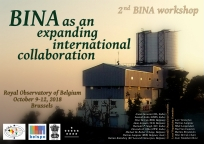Speaker
Prof.
Ram Sagar
(Indian Institute of Astrophysics)
Description
Both India and Belgium have jointly established two 4 meter class optical telescopes at Devasthal, Nainital (Longitude = 79º 41' 04" E; Latitude = 29 º 21' 40" N; Altitude= 2450 m) located in central Himalayan region of Kumaon, Uttarakhand, India. After successful installation of the 3.6 meter modern new technology Devasthal Optical Telescope (DOT) in 2015, it was technically activated by premiers of both countries from Brussels on March 30, 2016 while first light from 4 meter International Liquid Mirror Telescope (ILMT) is expected soon. Since 2016, the 3.6 m DOT has been used for both optical and near-Infrared (NIR) observations for a number of research proposals submitted primarily from astronomers of India and Belgium. The best recorded value of angular resolution is 0.4 arc second indicating that the optics of the 3.6 m DOT telescope is good and capable of providing images of the celestial bodies with sub arc second resolutions. All these observations provide proof that the care taken during the construction of the telescope houses has paid a rich dividend as their thermal mass is so low that it has not degraded the natural atmospheric seeing at Devasthal measured about 2 decades ago during 1997 – 1999 using differential image motion monitor.
A few preliminary scientific results obtained from recent observations will be presented in this review talk along with performance and global potential of the 3.6 m DOT in the field of galactic astronomy. The 3.6 m DOT is capable of providing internationally competitive science once high resolution spectrograph and other planned modern backend instruments become operational. Geographical location of the observatory has global importance for the time domain and multi-wavelength astrophysical studies. Both 4-m class observing facilities located at Devasthal have enormous potential as they can provide valuable optical and NIR observations for a number of front line galactic astrophysical research problems.
Primary author
Prof.
Ram Sagar
(Indian Institute of Astrophysics)
Co-authors
Prof.
Annapurni Subramaniam
(Indian Institute of Astrophysics)
Dr
Brijesh Kumar
(ARIES, Nainital)

